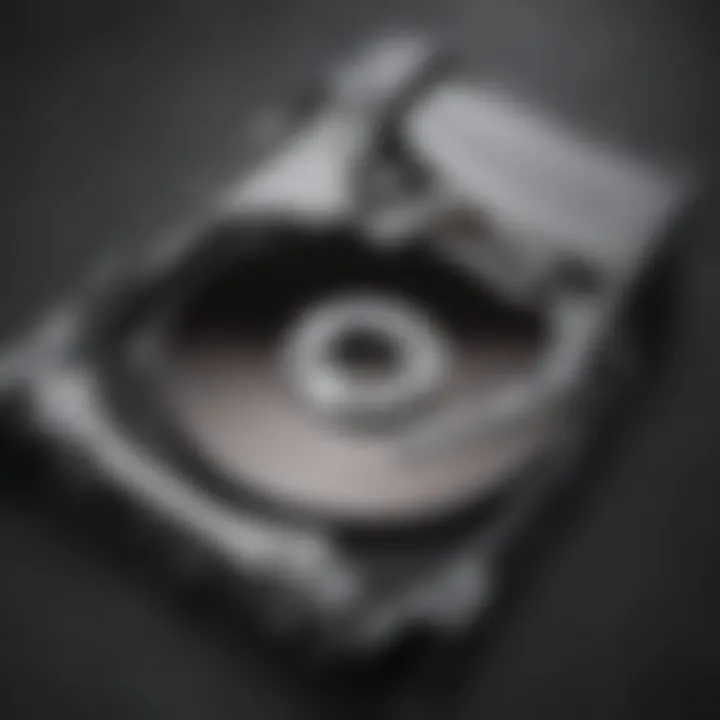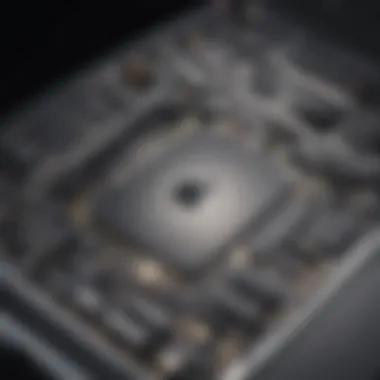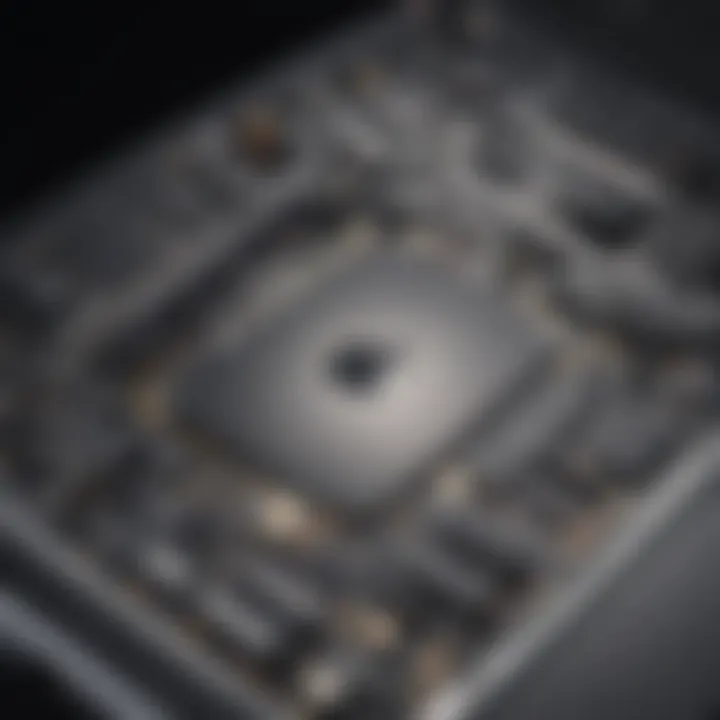Ultimate Guide to Replacing Your Mac Hard Drive


Intro
Replacing the hard drive in a Mac can be a daunting task for many users. Whether your goal is to enhance performance, expand storage capacity, or simply replace a failing drive, understanding the process is essential. This guide will walk you through every necessary step, providing clarity and confidence for both beginners and seasoned users alike. Knowing how to safely and effectively change a hard drive is a valuable skill in today’s technology-driven world.
By engaging with this article, you will learn not just how to replace a drive, but also how to ensure that data integrity is maintained throughout. Considering the value of the data stored on your devices, this emphasis on safety and efficiency is pivotal.
Throughout this guide, you will find insights, practical tips, and detailed instructions. Let’s dive into the first key section, which is the product overview of the Mac itself.
Foreword to Mac Hard Drive Replacement
Replacing the hard drive in a Mac is a significant task, but one that can yield substantial benefits. The hard drive stores all data, including the operating system, applications, and personal files. When issues arise, such as failures or slow performance, it may be necessary to consider replacement. This section serves to outline the relevance and importance of understanding the process of hard drive replacement.
Importance of Hard Drive Replacement
Hard drive replacement plays a critical role in maintaining the overall functionality of a Mac. When a hard drive fails or becomes obsolete, it can lead to a variety of performance problems. These may include longer load times for files and applications or even complete system crashes. A new hard drive can restore speed, improve response times, and enhance the overall user experience.
Moreover, the transition from traditional hard drives to solid-state drives (SSDs) is often advised. SSDs offer faster read/write speeds, leading to more efficient computing. Migrating to a high-capacity SSD can also accommodate the needs of users who work with large files, such as video editors or graphic designers. In this way, replacing the hard drive is not merely a correction of an issue; it can also be an upgrade to broaden capabilities and improve performance.
When to Consider Hard Drive Replacement
Deciding when to replace a Mac’s hard drive can depend on various factors. One primary indication is a noticeable decrease in performance. If applications take longer to open or files are sluggish to save, these could be signs of a deteriorating drive. Other red flags include random error messages and corrupted files. If these symptoms appear, assessing the health of the drive becomes urgent.
In addition, if the Mac has become too slow for multitasking or running modern applications, an upgrade is warranted. Users should consider the age of their system as well. A Mac that is several years old is likely to benefit from newer technology.
It is also prudent to replace the hard drive if data loss occurs or if there are continual issues that require frequent repairs. Proactively replacing a hard drive can prevent future headaches and data loss.
As technology advancements continue, being proactive about hardware maintenance can provide long-term benefits and performance enhancements for your Mac.
Understanding Mac Architecture
Understanding the architecture of a Mac system is crucial when replacing its hard drive. This knowledge not only facilitates a smoother replacement process but also aids in selecting the best compatible components. A Mac's internal structure has unique layouts and specifications that must be respected to ensure optimal performance and functionality. Therefore, a clear grasp of what makes up a Mac can dramatically ease the transition to a new hard drive.
Components of a Mac System
At the heart of a Mac system lies a combination of hardware, software, and peripherals that work together seamlessly. Key components include the central processing unit (CPU), memory (RAM), storage (hard drive), and the motherboard, along with various connectors and ports that integrate the system with devices like keyboards and displays.
- CPU: Acts as the brain of the computer. It handles all instructions from both hardware and software, making it a foundational component in terms of performance.
- RAM: Temporary storage that the CPU uses to store data and instructions it's currently processing. More RAM can significantly enhance multitasking capabilities.
- Storage: This includes hard drives, which hold the operating system, applications, and user data. The type and speed of the storage device impact boot times and application load times.
- Motherboard: The main circuit board that houses the CPU, RAM, and connections for other components.
Understanding these components not only highlights their roles but also aids users in identifying bottlenecks in their Mac's performance, particularly related to storage.
Types of Hard Drives
Selecting the right hard drive is essential for performance. Understanding the differences between hard drive types can impact system efficiency and user experience. The two main categories of hard drives to consider are:
HDD vs. SSD
Traditional hard disk drives (HDD) store data magnetically and are typically lower in cost for larger capacities. However, solid-state drives (SSD) use flash memory, which offers much faster data access and higher reliability. Users should consider their primary needs when choosing:
- Advantages of HDD:
- Advantages of SSD:
- Performance: Generally, SSDs provide a quicker user experience with snappier responses in applications and faster boot times, marking them as a beneficial choice for most use cases in this article.
- More affordable for larger storage.
- Suitable for users with extensive media libraries or large files who need capacity without speed enhancement.
- Significantly faster data access speeds.
- Enhanced durability due to no moving parts, making them less susceptible to mechanical failure.
External vs. Internal Drives
Deciding between external and internal drives is also important.
- Internal Drives: Install directly into the Mac, providing a seamless integration that usually enhances performance with faster data transfer rates. Ideal for users looking to upgrade their systems significantly.
- External Drives: Offer flexibility, allowing for easy data transfer between multiple devices. They are beneficial for backup solutions and can be a temporary storage fix when on the move.
External drives are great for additional storage but may not match the speed of internal drives, particularly for high-performance tasks.
Preparing for the Replacement
Preparing for a hard drive replacement is a critical phase in achieving a successful upgrade. This step ensures that you have all the necessary tools and processes in place before you start dismantling your Mac. By taking time to prepare, you minimize the risk of errors, data loss, and damage to your device. Proper preparation can significantly enhance your efficiency during the replacement process and safeguard your data.
Gathering Necessary Tools
Screwdrivers


Screwdrivers are essential for opening your Mac and accessing the hard drive. Most Macs require specific types of screwdrivers, particularly Phillips and flathead types. A key characteristic of screwdrivers is the size and type of the tip. It is important to choose the right size to ensure a snug fit in the screw, which prevents stripping the head.
Using a torx screwdriver can be beneficial due to its unique shape that offers better grip and torque. This is especially useful in tightly secured screws often found in modern Macs. Having the right screwdriver can make a significant difference in how smoothly the replacement goes.
Prying Tools
Prying tools help in safely opening the casing of your Mac without damaging the internal components. These tools are often made of plastic which helps to prevent scratches on the metal. A primary advantage of using prying tools is their design, which allows you to exert necessary pressure without risking damage to delicate parts.
The use of plastic prying tools specifically reduces the chances of static buildup, which is a notable risk when dealing with electronics. Using these tools is a necessary aspect of the replacement task that enhances precision and care.
Anti-Static Wrist Strap
An anti-static wrist strap is crucial for protecting electronic components from electrostatic discharge (ESD). When working on electronics, one can easily accumulate static electricity, which can be harmful to sensitive components. The main feature of an anti-static wrist strap is its ability to discharge any static buildup safely to the ground.
This tool is essential for anyone performing hardware modifications, as it ensures that the components remain safe from potential damage. It is also simple to use—just attach it to your wrist and connect the clip to a grounded surface, and you are ready to work with minimal risk.
Backing Up Your Data
Backing up your data ahead of a hard drive replacement is another critical step. It protects your valuable files from accidental loss during the replacement process. One of the most effective methods for backing up data is to use software designed for this purpose.
Using Time Machine
Time Machine is Apple's built-in backup feature that automates the process of backing up your data. It allows users to back up the entire system, including applications, files, and system preferences. This method is highly regarded for its ease of use; once set up, it does the work automatically.
The unique feature of Time Machine is its incremental backup capability, allowing you to restore your system to any point in time. This provides a safety net in case of failure during installation. Overall, Time Machine is a powerful option for maintaining data integrity during hardware replacements.
Manual Backup Options
Manual backup is an alternative for those who prefer a hands-on approach. This involves copying files directly to external storage devices, such as USB drives or external hard disks. One key characteristic of manual backup is its flexibility—you can choose what to backup based on your priorities.
While manual backups are straightforward, they are more time-consuming and susceptible to human error. It requires attention and discipline to ensure that all critical files are copied. Nonetheless, for individuals wanting more control over their backups, this method remains a valid choice.
Identifying the Right Replacement Hard Drive
Choosing the appropriate replacement hard drive for your Mac is an essential step in ensuring the longevity and performance of your device. With various options available in the market, understanding key specifications will help you make an informed decision. Proper selection can prevent issues related to speed, capacity, and device compatibility, ultimately enhancing user experience.
Specifications to Consider
Capacity
Capacity refers to the amount of data a hard drive can hold. It is measured in gigabytes (GB) or terabytes (TB). For most users, the capacity should fulfill their storage needs without resorting to external solutions. A hard drive with a larger capacity can store more files such as images, videos, and applications. This is particularly advantageous for multimedia professionals or gamers, who often handle large data files. On the other hand, it is important to note that higher capacity drives can be pricier. Therefore, determining the storage requirements before purchase is crucial.
Speed
Speed is another significant factor when selecting a hard drive. It defines how quickly data can be read from or written to the drive, usually measured in revolutions per minute (RPM) for HDDs and in megabytes per second (MB/s) for SSDs. Solid State Drives (SSDs) are known for their superior speed compared to traditional Hard Disk Drives (HDDs). This characteristic leads to faster boot times, quicker file transfers, and improved overall system performance. However, SSDs tend to be more costly per gigabyte compared to HDDs. Choosing the right speed is about balancing performance needs and budget constraints.
Compatibility
Compatibility addresses how well a hard drive works with your specific Mac model. Not all hard drives fit all systems due to differing physical dimensions and connection interfaces. Before making a purchase, confirming that the drive supports your Mac's hardware is essential. Some drives are optimized for Macs and provide additional features like specific firmware. Using compatible drives can lead to better performance and efficiency in your system with less risk of issues arising during installation.
Recommended Hard Drives for Mac
For those unsure of which options to consider, several well-regarded hard drives specifically designed for Mac are available. Brands such as Samsung and Crucial offer SSDs that boast high performance and reliability. On the other hand, Western Digital provides a range of HDDs that are known for their durability and capacity options. \nIn sum, determining the right replacement hard drive hinges upon understanding your specific storage, speed, and compatibility needs. This knowledge will assure better performance and a smoother user experience after the replacement process.
Step-by-Step Replacement Process
The step-by-step replacement process is critical for any individual looking to replace their Mac's hard drive. This segment brings clarity to potentially daunting technical tasks, offering a clear roadmap. A thorough understanding of this process ensures that users minimize risks, like data loss or hardware damage. Each step is designed to build on the previous one, leading you toward a successful replacement. This meticulous approach simplifies what might seem overwhelming, especially for those who are not tech-savvy.
Shutting Down and Disconnecting Power
Before making any hardware changes, shutting down your Mac and disconnecting power is essential. This action ensures safety and prevents electrical damage to components. A complete shutdown allows the internal circuits to fully discharge, further safeguarding against static electricity. When you disconnect the power cord, any inadvertent surges are avoided. Therefore, this simple step is pivotal as it creates a safe working environment.
Gaining Access to the Hard Drive
Removing the Back Cover
Removing the back cover is often the first hands-on task in the replacement process. It is a straightforward procedure that varies slightly depending on the Mac model. Typically, this involves unscrewing a series of screws. The importance of this step cannot be overstated, as gaining access is required to reach the hard drive.
A key characteristic of removing the back cover is the design of the device itself. Many Macs have a non-intrusive design, which makes access relatively simple but may require specific tools. The advantage of this feature is that it facilitates routine maintenance and upgrades without professional involvement. However, improper handling can lead to cosmetic damage or issues with reassembly, which is a risk to keep in mind.


Locating the Hard Drive
Once you have successfully removed the back cover, the next task is locating the hard drive. This step is crucial to ensure that you are focused on the right component. Usually, the hard drive is positioned in a specific area, often secured with brackets or screws. Knowing its exact location makes the removal process more efficient.
A significant aspect of locating the hard drive is understanding your Mac's layout, which can differ between models. This consideration is beneficial because it gives users a clear direction during the replacement. The unique feature here is that the hard drive often has identifiable markings that can aid your search. However, be mindful that without prior knowledge, it may take longer than expected to find it, which could be frustrating.
Removing the Old Hard Drive
Removing the old hard drive is a decisive step in the replacement process. This task may require some finesse since drives can be secured with several screws or clips. It is essential to carefully detach any connectors to avoid damaging them, which ensures that new parts can be installed correctly. The need for tools like screwdrivers during this phase cannot be overstated. Having the right tools will facilitate a smoother and more efficient process.
Installing the New Hard Drive
Installing the new hard drive follows the removal of the old one. This stage requires attention to detail as consistent connection is vital for the device functionality. Make sure to align the drive properly to avoid issues later on.
Securing the New Drive
Securing the new drive is essential for ensuring stability within the Mac's framework. This step involves firmly affixing the drive using screws or brackets. The key advantage of a secured drive is that it minimizes the risk of hardware failure caused by movement or vibration during use. A well-secured drive promotes longevity and performance, emphasizing its importance in the replacement process.
Reattaching Connectors
Reattaching connectors is a final yet critical step in the installation process. This involves securely connecting all data and power cables to the new hard drive. The unique feature of this action is its straightforward nature, yet it significantly impacts the system's functionality. If connectors are improperly attached, the new drive may not function. Therefore, ensuring all connections are solid is paramount before moving on to reassembly.
Reassembling the Mac
Reassembling the Mac after replacing the hard drive is a crucial phase in the overall process. This step is not merely about closing the device; it involves ensuring that everything is returned to its original state to guarantee proper function. A careful approach is essential to avoid damaging any internal components or misaligning any parts. Taking your time during this task will prevent future issues and provide peace of mind when using your Mac again.
Replacing the Back Cover
Once the new hard drive is securely installed, the next step is to replace the back cover of the Mac. This action is fundamental for protecting the internal components from dust, moisture, and other environmental factors. Failing to securely attach the back cover can lead to hardware malfunctions later on.
- Align the Cover: Start by correctly aligning the back cover with the chassis. Ensure that no cables are pinched or obstructed.
- Secure the Screws: Use the appropriate screwdriver to replace the screws that hold the back cover in place. Be careful not to overtighten them, as this could strip the screw holes.
- Check for Gaps: Before finishing, inspect the edges to ensure there are no noticeable gaps, which might indicate that the cover is not seated properly.
take note: if you have changed any internal components besides the hard drive, ensure you have reconnected them properly before proceeding to close the device.
Powering On the Device
After successfully replacing the back cover, the moment of truth arrives; it is time to power on the device. This step serves multiple purposes. It allows you to verify that the installation has been executed properly and ensures that the new hard drive is functioning as intended.
- Connect the Power Source: Attach the power adapter to the Mac. It is not advisable to attempt powering on the device without a reliable power source.
- Press the Power Button: Locate the power button and press it, observing the startup process. Listen for any unusual sounds, and watch for signs that the system recognizes the new hard drive.
- Troubleshoot if Needed: If the Mac does not boot up, there could be several factors at play. Double-check the connections and ensure the hard drive is seated correctly. If problems persist, consult resources on platforms like reddit.com or wikipedia.org for troubleshooting advice.
Proper reassembly is more than just a closing task; it ensures longevity and performance integrity of your device.
Taking extra care during reassembly contributes significantly to the overall reliability and performance of your Mac after a hard drive replacement.
Configuring the New Hard Drive
Configuring the new hard drive is a critical step in the process of replacing your Mac's hard drive. This section discusses how to properly prepare the new drive for use, ensuring both optimal performance and data integrity. A well-configured hard drive can significantly enhance your Mac's efficiency, reliability, and overall user experience. It is essential to carefully follow the steps outlined here to set up the new hard drive effectively.
Formatting the New Hard Drive
Formatting the new hard drive is fundamental before you can use it. This process involves setting up a file system that macOS can use to manage and store data. The most common file system for Macs is APFS (Apple File System), especially useful for SSDs due to its performance benefits.
- Connect the New Hard Drive: Install the new drive into your Mac and ensure it's securely connected.
- Open Disk Utility: Navigate to Applications > Utilities > Disk Utility. This tool allows you to manage disks and storage devices on your Mac.
- Select the New Hard Drive: In Disk Utility, find your new hard drive in the sidebar. Make sure to select the correct drive to avoid accidents.
- Erase and Format the Drive: Choose the "Erase" option. In the dialog that appears:
- Verify the Format: Once the process is complete, confirm that the drive is formatted correctly and shows up in the Finder.
- Name your drive.
- Select or , depending on your needs.
- Click "Erase" to format the drive.
By formatting the drive properly, you prepare it to accept new data and ensure it operates effectively within macOS.
Restoring Data from Backup
After formatting the new hard drive, you will want to restore your previous data to it. This ensures that all your important files, settings, and applications are transferred correctly. Here’s a brief guide on how to do this:
- Use Time Machine: If you utilized Time Machine for backups, connect your Time Machine drive to your Mac.
- Manual Restoration: If you did a manual backup (like copying files to an external drive), connect that external drive.
- Reinstall Applications: For applications, ensure that you have installation files or access to them. Some apps might require downloading again from the App Store or official websites.
- Open the Migration Assistant located in Applications > Utilities.
- Follow the prompts to select the backup you wish to restore from.
- Open Finder and navigate to the files you had backed up.
- Drag and drop necessary files and folders back to your new hard drive.
This careful restoration of data ensures that your transition to the new hard drive is smooth and maintains the usability of your system.


Remember: Always double-check that you have a complete backup before starting any replacement process. Post-replacement, ensure all vital files are accessible and applications are functioning as intended.
Post-Replacement Considerations
Replacing a hard drive in a Mac is a significant task that extends beyond just the physical changing of components. Once the new drive is installed, there are critical steps that ensure it operates correctly and efficiently. Post-replacement considerations form the backbone of a successful upgrade or replacement. They include testing the new hard drive, optimizing its performance, and ensuring that it integrates seamlessly with the existing system.
Testing the New Hard Drive
Following the installation of a new hard drive, it is essential to test its functionality. This does not only verify that the hardware is operational but also identifies any potential issues that could arise. Here are some suggested methods for testing:
- Disk Verification: Use the built-in Disk Utility application available on all Macs. This tool allows you to check for errors on the new hard drive and verify its integrity. Running a first aid check ensures that the drive is healthy and that any corruption is addressed before data is transferred or programs are run.
- Read and Write Tests: It is prudent to carry out simple read and write tests. Create a dummy file and write it onto the new drive. Then attempt to open this file to ensure it performs correctly. This step helps in recognizing any immediate issues with the hard drive itself.
Through testing, you can ensure that the new hard drive is ready for use and that no underlying problems persist.
Optimizing Performance
Getting the most out of your new hard drive involves more than just installation and testing. You need to optimize its performance for better efficiency. Here are two key methods to improve the drive’s functionality:
Disk Utility
Disk Utility plays a pivotal role in enhancing the drive's performance. This application can be used for more than just repairs. It can format the drive, partition it, and create disk images. Its most crucial function is the ability to perform maintenance tasks such as checking and repairing disk errors.
One of its key characteristics is user-friendliness. Even for those not well-versed in technical jargon, Disk Utility's straightforward interface allows users to navigate easily.
A unique feature of Disk Utility is that it provides detailed information about the drive's health status. Using SMART (Self-Monitoring, Analysis, and Reporting Technology), it offers insights into various metrics, giving users a comprehensive view of the drive's operating condition. This insight can be beneficial, showing when issues might need to be addressed before they lead to data loss.
Monitoring Tools
Monitoring Tools are crucial for ongoing performance evaluation. These applications allow users to keep an eye on the hard drive's activity and health after installation. They notify you of abnormal activities or failures that might occur in real-time.
One notable characteristic of monitoring tools is their analytic capability. They can track disk usage, temperature, and read/write speed, providing valuable data to help identify performance bottlenecks.
A key benefit of these tools is their capacity for proactive management. By receiving alerts about potential issues, users can take preventative action, thereby prolonging the drive's lifespan and ensuring optimal performance. However, they might require a learning curve to understand the metrics fully.
"Regular monitoring of your Mac's hard drive performance can prevent larger issues, saving time and potential data loss in the future."
Troubleshooting Common Issues
Troubleshooting common issues during and after the hard drive replacement process is crucial. It enables users to identify and resolve problems effectively, ensuring a smooth transition to the new hardware. Addressing these issues promptly can save time and prevent further complications. This section delves into two significant problems that may arise: a drive not recognized by the system, and long boot times. Understanding these issues and their respective solutions is essential for maintaining the performance and functionality of your Mac.
Drive Not Recognized
Upon replacing your Mac's hard drive, you might encounter a situation where the system fails to recognize the new drive. This issue can stem from several factors.
- Connection Issues: Ensure that the new hard drive is properly connected. Check connections between the drive and the port. Sometimes, a loose cable can hinder the device from being detected.
- Compatibility Problems: Verify that the hard drive you purchased is compatible with your Mac model. Specific Macs require drives with particular specifications or interfaces, such as SATA or NVMe.
- Formatting Errors: Macs utilize a specific file system, known as APFS or HFS+. If the new drive isn’t formatted correctly, your Mac may not recognize it. Use Disk Utility to reformat the drive to the appropriate format.
- Firmware Updates: In some cases, a firmware update on the Mac may be necessary for optimal drive recognition. Check for available updates through macOS settings.
To troubleshoot this issue, follow these steps:
- Restart the Mac and see if the drive is recognized.
- Open Disk Utility to check if the drive appears there. If it does, you can proceed to format it. If not, recheck the physical connections.
"If your Mac does not recognize the new hard drive, it is crucial to verify connections and compatibility first."
Long Boot Times
Another common issue that users may face after replacing their hard drive is prolonged boot times. This delay can be attributed to various factors that might interfere with the Mac's performance.
- Improper Installation: If the hard drive is not installed properly, it may cause the system to struggle during the startup process. This could be the result of not securing the drive adequately or misplacing connectors.
- Operating System Configuration: After a new installation, the operating system may require additional configurations. If this involves migration from an old drive, the process may take longer if there is data overload.
- Drive Speed: Solid-state drives provide faster boot times compared to traditional hard disk drives. If you replaced an SSD with an HDD, you might experience longer boot times due to the nature of the drives.
- Background Processes: Sometimes, background processes can slow down startup. You can check for programs that automatically launch at startup and disable any unnecessary ones.
To mitigate long boot times, consider these actions:
- Double-check the physical setup of the hard drive to ensure proper installation.
- Review startup items in System Preferences and remove any that are not needed.
- If all else fails, consider reinstalling macOS or performing an SMC reset to refresh system management settings.
Being aware of these common issues can prepare users for quick resolutions. Understanding the root causes enhances the ability to maintain your Mac’s performance post-replacement.
The End
Replacing the hard drive in your Mac is a significant task, one that can greatly improve your device's performance and extend its lifespan. The completion of this process is not merely about swapping out hardware; it is an opportunity to enhance the overall user experience. This article provides a structured approach to ensure that readers can confidently tackle this challenge themselves. Understanding the importance of this topic means recognizing how a new hard drive can lead to faster boot times, quicker application launches, and the ability to store more data than ever before.
Recap of the Replacement Process
The replacement process involves several critical steps to ensure success. First, it is crucial to gather the right tools, which include screwdrivers, prying tools, and an anti-static wrist strap. Protecting your data through a solid backup method is also essential before you begin. After preparing, you gain physical access to the hard drive by removing the back cover, locating, and carefully extracting the old hard drive. This can be a delicate operation, and it is vital to follow the steps closely to avoid damage. Next, you install the new hard drive, ensuring secure connections and proper seating.
After reassembly, the new drive must be formatted to work correctly with your Mac. Restoring data from your backup follows this step to get your system back to its original functionality. Testing the new hard drive is essential to verify that it is functioning as expected and addressing any post-replacement issues that may arise.
Final Thoughts on Maintenance
Regular maintenance of your Mac’s hard drive can prevent various issues down the road. After replacement, users should monitor drive health using tools available through macOS. Disk Utility, for instance, assists in managing disk functions and can help with formatting tasks. Keeping an eye on performance metrics ensures that any gradual decreases in functionality are addressed promptly. Furthermore, leveraging software options for monitoring can give insights into the drive’s status.



